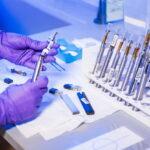When it comes to the planning of a clinical development program, there are a number of key steps that must be followed in order to ensure success. After all, this is not something that can be left to chance, as the implications could be far-reaching and potentially devastating.
The first step is to clearly define the goals of the program. What are you hoping to achieve? What are the targets that need to be met in order for the program to be considered a success? Once these have been established, you can then start to put together a plan of action.
And speaking of action, let’s dive into this matter in-depth with a complete list of the clinical development steps you must take in your program.
1. Define the goals and objectives of the program
First and foremost, you need to lay out what it is you’re hoping to achieve with the clinical development program. What are the specific targets that need to be met? Once these have been established, you can start putting together a plan of action.
When defining goals, you should also consider the overall strategy of the program. What are the key milestones that need to be reached? What are the timelines for each stage of development? By having a clear understanding of the big picture, you’ll be in a better position to develop a tailored plan that meets the needs of your program.
2. Identify the target population
The next step is to identify the target population for the clinical development program. Who will be participating in the trials? What are their demographics? What are their medical histories?
By understanding the target population, you’ll be able to design trials that are more likely to produce positive results. In addition, you’ll be able to tailor the recruitment process to attract individuals who are more likely to participate and complete the program.
3. Develop the protocol
After the goals and target population have been identified, it’s time to start developing the protocol for the clinical development program. This document will detail every aspect of the trials, from the inclusion/exclusion criteria to the schedule of assessments.
The protocol should be designed with input from all stakeholders, including investigators, sponsors, and regulatory agencies. In addition, it should be reviewed by an independent body such as an Institutional Review Board (IRB) to ensure its ethical integrity.
4. Select the investigators
Once the protocol has been developed, it’s time to select the investigators who will be responsible for conducting the trials. These individuals should be experienced in both research and clinical practice. In addition, they should have a good understanding of the target population and the disease/condition being studied.
Read Also
- Creative Approaches to Alleviating Healthcare Staff ShortagesHospitals and clinics are facing staff shortages, which makes it harder to take care of patients well. Finding simple and useful solutions is very important. Easy changes like flexible work hours, good training, and chances to grow can help staff stay happy. Technology, like online doctor visits and helpful tools, can make work easier. Smart… Read more: Creative Approaches to Alleviating Healthcare Staff Shortages
- Understanding the Role of Sterilizers in Healthcare FacilitiesHave you ever wondered how hospitals keep their equipment safe enough to use on dozens of patients every day? Most people never think about what happens behind the scenes, yet these hidden steps play a huge role in patient safety. Sterilizers are part of that system, working quietly to remove harmful germs before any instrument… Read more: Understanding the Role of Sterilizers in Healthcare Facilities
- Building Healthcare Access Where It’s Needed Most: A Local First ApproachHealthcare shouldn’t depend on where you live. But in the U.S., it often does. If you’re in a big city, you likely have options. If you’re in a small town or an underserved neighbourhood, it’s a different story. To fix this, more healthcare leaders are turning to a local-first approach. That means putting clinics and… Read more: Building Healthcare Access Where It’s Needed Most: A Local First Approach
- Revolutionizing Patient Engagement: Innovative Solutions for Improved Care and Treatment SuccessNavigating healthcare system can often feel overwhelming for patients. Between appointments, prescriptions, and treatment regimens, it’s easy for crucial details to get lost in the shuffle. That’s why effective patient engagement and support solutions are more important than ever. Companies like Serva Health, with their pharma hub services, are stepping up to ensure that patients… Read more: Revolutionizing Patient Engagement: Innovative Solutions for Improved Care and Treatment Success
- On-Demand Healthcare Staffing As A Cost-Saving StrategyThis is an exciting and challenging time for the healthcare industry. Technology is advancing almost faster than humans can keep pace. New legislation is creating fresh challenges for the future of healthcare, and the shifting population demographic continues to place more pressure on healthcare facilities. Amidst these changes, healthcare facilities are facing a critical staffing… Read more: On-Demand Healthcare Staffing As A Cost-Saving Strategy
5. Conduct the trials
After the investigators have been selected, it’s time to start conducting the clinical trials. This process can be divided into three phases:
Phase I trials are conducted in a small group of individuals (usually 20-80) to assess safety and tolerability.
Phase II trials are conducted in a larger group of individuals (usually 100-300) to assess efficacy.
Phase III trials are conducted in an even larger group of individuals (usually 1,000-3,000) to confirm efficacy and compare the new treatment to existing standard of care treatments.
6. Analyze the data
After the trials have been completed, it’s time to start analyzing the data. This process involves reviewing all of the data collected during the study, including both efficacy and safety data.
The analysis should be conducted by a team of experts, including statisticians, epidemiologists, and clinicians. In addition, the data should be reviewed by an independent body such as the Data and Safety Monitoring Board (DSMB) to ensure its accuracy and completeness.
7. Submit for approval
Once the clinical development program is complete and all of the data has been analyzed, it’s time to submit a New Drug Application (NDA) or Biologic License Application (BLA) to the FDA for approval.
This process can take several months to complete, so it’s important to start preparing the application well in advance. In addition, you’ll need to work closely with the FDA throughout the review process to ensure that all of their concerns are addressed.
8. Launch the product
After the clinical development program is complete and the product has been approved by the FDA, it’s time to launch it on the market. This process involves commercializing the product and making it available to patients.
It’s important to note that launching a new product is a complex undertaking, so it’s important to have a solid plan in place before starting. In addition, you’ll need to work closely with payers, providers, and patients to ensure that the product is accessible and affordable.
Other Factors to Consider
In addition to the eight steps above, there are a few other factors to keep in mind when developing a clinical development program:
1. Timing is everything: The clinical development process can take many years to complete, so it’s important to start planning early. In addition, you’ll need to be flexible and adaptable throughout the process, as delays are common.
2. Cost is a major factor: Clinical trials are expensive, so you’ll need to have a solid financial plan in place before starting. In addition, you may need to raise money from investors or grant-makers to fund the program.
3. Regulation is complex: The FDA has strict regulations surrounding clinical trials, so it’s important to understand the process before starting. In addition, you’ll need to work closely with the FDA throughout the development process.
4. Results are never guaranteed: Clinical trials are complex and results are never guaranteed. There’s always a risk that a trial will not produce the desired results, so it’s important to be prepared for this possibility.
5. Patience is key: The clinical development process can take many years to complete, so it’s important to be patient. It can be tempting to rush things, but it’s important to take the time needed to ensure that the product is safe and effective.
The clinical development process is long and complex, but it’s essential for bringing new treatments to market. By following these eight steps, you can ensure that your product has the best chance of success.






